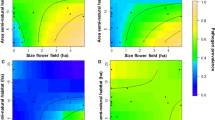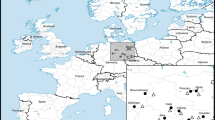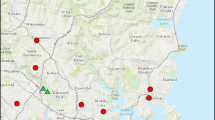Abstract
As urban areas continue to expand globally, animal biodiversity is likely to experience altered habitat conditions, resource levels, and pathogen dynamics, with critical implications for insect pollinators. Specifically, local and regional land management may impact pollinator infectious disease prevalence, and this may be particularly relevant in urban garden systems where local food production depends on crop pollination. Further, because multi-host parasites can be spread across insect pollinator communities with varying impacts on host species, changes in pollinator community composition can lead to ‘amplification’ or ‘dilution’ effects, whereby increases in pollinator diversity could lead to higher or lower rates of parasitism, respectively. In this study, we investigate how urban garden management and regional landscape composition structure disease dynamics for a critical native pollinator, the bumble bee Bombus vosnesenskii. Parasite prevalence in our gardens was low in Nosema ceranae (1.06%) and Nosema bombi (1.06%), and Crithidia expoekii (0.5%), while we observed higher prevalence of Crithidia bombi (18%) and Apicystis bombi (6.4%). We found that gardens with higher pollinator taxonomic richness had significantly lower prevalence of Apicystis bombi in B. vosnesenskii hosts, providing evidence for the dilution effect. We also found that the prevalence of the parasite Crithidia bombi was significantly higher in gardens with higher mulch use and in gardens surrounded by greater proportions of impervious urban cover. Overall, we document a wide range of stressors facing urban bees, and show that parasitism is mediated by local ground management, regional land use, and pollinator community composition.

Similar content being viewed by others
Availability of data and material
Will be made available on DRYAD repository upon publication.
Code availability
Will be made available on GitHub upon publication.
Literature Cited
Altizer S, Ostfeld RS, Johnson PTJ, Kutz S, Harvell CD (2013) Climate change and infectious diseases: from evidence to a predictive framework 341:7
Anderson MAJ (2019) Parasite Insight: Apicystis bombi: Prevalence of under-reported parasite Apicystis bombi across natural barriers and life stages in pollinator hosts. [Unpublished Master’s Thesis] University of Exeter
Bailes EJ, Deutsch KR, Bagi J, Rondissone L, Brown MJF, Lewis OT (2018) First detection of bee viruses in hoverfly (syrphid) pollinators. Biol Let 14(2):20180001
Bailes EJ, Bagi J, Coltman J, Fountain MT, Wilfert L, Brown MJF (2020) Host density drives viral, but not trypanosome, transmission in a key pollinator. Proc R Soc B Biol Sci 287(1918):20191969
Baldock K, Goddard M, Hicks D, Kunin E, Mitschunas N, Morse H, Osgathorpe L, Potts S, Robertson K, Scott A, Staniczenko P, Stone G, Vaughan I, Memmott J (2019) A systems approach reveals urban pollinator hotspots and conservation opportunities. Nature Ecol Evol 3:363–373
Baldock KCR, Goddard MA, Hicks DM, Kunin WE, Mitschunas N, Osgathorpe LM, Potts SG, Robertson KM, Scott AV, Stone GN, Vaughan IP, Memmott J (2015) Where is the UK’s pollinator biodiversity? The importance of urban areas for flower-visiting insects. Proc R Soc B Biol Sci 282(1803):20142849
Ballare K, Neff J, Ruppel R, Jha S (2019) Ecol Appl 2019:e01869
Barton K (2012) Package MuMIn: model selection and model average based on information criteria (AICc and alike). CRAN R Project. http://www.R-project.org/
Bates D, Maechler M, Bolker B, Walker S, Christensen RHB, Singmann H, Dai B, Scheipl F, Grothendieck G, Green P, Fox J. (2011) Package ‘lme4’. Linear mixed-effects models using 'Eigen' and S4 classes. R package version, 1–1.
Bruggisser OT, Schmidt-Entling MH, Bacher S (2010) Effects of vineyard management on biodiversity at three trophic levels. Biological Conservation 143:1521-1528.
Civitello D, Cohen J, Fatima H, Halstead N, Liriano J, McMahon T, Ortega N, Sauer E, Sehgal T, Young S, Rohr J (2015) Biodiversity inhibits parasites: Broad evidence for the dilution effect. Proc Natl Acad Sci 112(28):8667–8671
Cohen H, Quistberg RD, Philpott SM (2017) Vegetation Management and Host Density Influence Bee-Parasite Interactions in Urban Gardens. Environ Entomol 46(6):1313–1321
Cohen H, Egerer MH, Lin BB, Liere H, Bichier P, Philpott SM, Jha S (2021) The relationship between pollinator community and pollination services in urban landscapes is mediated by floral abundance. Urban Ecosyst 24:275–290
Cohen H, Ponisio LC, Russel KA, Philpott SM, McFrederick QS (2022) Floral resources shape parasite and pathogen dynamics in bees facing urbanization. Mole Ecol 2022;001:1-15
Cordes N, Huang WF, Strange JP, Cameron SA, Griswold TL, Lozier JD, Solter LF (2012) Interspecific geographic distribution and variation of the pathogens Nosema bombi and Crithidia species in United States bumble bee populations. J Invertebr Pathol 109(2):209–216
Cusser S, Neff J, Jha S (2018) Land-use history drives contemporary pollinator community similarity. Landscape Ecol 17
Deshwal S, Mallon EB (2014) Antimicrobial peptides play a functional role in bumblebee anti-trypanosome defense. Dev Comp Immunol 42(2):240–243. https://doi.org/10.1016/j.dci.2013.09.004
Doums C, Schmid-Hempel P (2000) Immunocompetence in workers of a social insect, Bombus terrestris L., in relation to foraging activity and parasitic infection. Can. J. Zool. 78:1060-1066
Descamps C, Quinet M, Jacquemart A-L (2021) The effects of drought on plant–pollinator interactions: What to expect? Environ Exp Bot 182:104–297
Egerer MH, Arel C, Otoshi MD, Quistberg RD, Bichier P, Philpott SM (2017) Urban arthropods respond variably to changes in landscape context and spatial scale. J Urban Ecol 3(1)
Egerer MH, Lin BB, Liere H, Jha S, Bichier P, Philpott SM (2018) People or Place? Neighborhood opportunity influences community garden soil properties and soil-based ecosystem services. Int J Biod Sci, Eco Services & Mngt, 14:1, 32-44
Egerer M, Ordóñez C, Lin BB, Kendal D (2019) Multicultural gardeners and park users benefit from and attach diverse values to urban nature spaces. Urban Forestry & Urban Greening 46(2019) 126445.
Figueroa LL, Blinder M, Grincavitch C, Jelinek A, Mann EK, Merva LA, Metz LE, Zhao AY, Irwin RE, McArt SH, Adler LS (2019) Bee pathogen transmission dynamics: Deposition, persistence and acquisition on flowers. Proc R Soc B 286(1903)
Fox J, Weisberg S (2011) An R companion to applied regression, 2nd edn. Sage, Thousand Oaks, CA
Goulson D, Whitehorn P, Fowley M (2012) Influence of urbanization on the prevalence of protozoan parasites of bumblebees. Ecol Entomol 37(1):83–89
Grass I, Jauker B, Steffan-Dewenter I, Tscharntke T, Jauker F (2018) Past and potential future effects of habitat fragmentation on structure and stability of plant–pollinator and host–parasitoid networks. Nature Ecol Evol 2(9):1408–1417
Graystock P, Goulson D, Hughes WOH (2014) The relationship between managed bees and the prevalence of parasites in bumblebees. PeerJ 2:e522
Graystock P, Goulson D, Hughes WO (2015) Parasites in bloom: flowers aid dispersal and transmission of pollinator parasites within and between bee species. Proc R Soc B Biol Sci 282(1813):20151371
Graystock P, Ng WH, Parks K, Tripodi AD, Muñiz PA, Fersch AA, Myers CR, McFrederick QS, McArt SH (2020) Dominant bee species and floral abundance drive parasite temporal dynamics in plant-pollinator communities. Nature Ecol Evol 4(10):1358–1367
Hall DM, Camilo GR, Tonietto RK, Ollerton J, Ahrné K, Arduser M, Ascher JS, Baldock KCR, Fowler R, Frankie G, Goulson D, Gunnarsson B, Hanley ME, Jackson JI, Langellotto G, Lowenstein D, Minor ES, Philpott SM, Potts SG, Sirohi MH, Spevak EM, Stone GN, Threlfall CG (2017) The city as a refuge for insect pollinators: Insect Pollinators. Conserv Biol 31(1):24–29
Harrison T, Winfree R (2015) Urban drivers of plant-pollinator interactions. Funct Ecol 29(7):879–888
Homer CG, Dewitz JA, Yang L, Jin S, Danielson P, Xian G, Coulston J, Herold N, Wickham J, Megown K (2015) Completion of the 2011 National Land Cover Database for the conterminous United States – Representing a decade of land cover change information. Photog Eng Rem Sens 81:345–354
Huang ZYX, van Langevelde F, Prins HHT, de Boer WF (2015) Dilution versus facilitation: Impact of connectivity on disease risk in metapopulations. J Theor Biol 376:66–73
Jha S, Kremen C (2013) Resource diversity and landscape-level homogeneity drive native bee foraging. Proc Natl Acad Sci 110(2):555–558
Johnson P, Preston D, Hoverman J, Richgels K (2013) Biodiversity decreases disease through predictable changes in host community competence. Nature 494:230–233
Jones KE, Patel NG, Levy MA, Storeygard A, Balk D, Gittleman JL, Daszak P (2008) Glob Trends Emerg Infect Dis 451:5
Julier HE, Roulston TH (2009) Wild Bee Abundance and Pollination Service in Cultivated Pumpkins: Farm Management, Nesting Behavior and Landscape Effects. J Econ Entomol 102(2):563–573
Keesing F, Holt RD, Ostfeld RS (2006) Effects of species diversity on disease risk. Ecol Lett 9:485–498
Konig C, Schmid-Hempel P (1995) Foraging activity and immunocompetence in workers of the bumble bee, Bombus L. Proc R Soc Lond B 260:225–227
Kratschmer S, Pachinger B, Schwantzer M, Paredes D, Guzmán G, Goméz JA, Entrenas JA, Guernion M, Burel F, Nicolai A, Fertil A, Popescu D, Macavei L, Hoble A, Bunea C, Kriechbaum M, Zaller JG, Winter S (2019) Response of wild bee diversity, abundance, and functional traits to vineyard inter-row management intensity and landscape diversity across Europe. Ecol Evol 9(7):4103–4115
Kremen C, Williams NM, Thorp RW (2002) Crop pollination from native bees at risk from agricultural intensification. Proc Natl Acad Sci 99(26):5
Lin BB, Egerer MH (2020) Global social and environmental change drives the management and delivery of ecosystem services from urban gardens: A case study from Central Coast, California. Glob Environl Chang 60:102006
Lipa JJ, Triggiani O (1996) Apicystis gen nov and Apicystis bombi (Liu, Macfarlane and Pengelly) comb nov (Protozoa: Neogregarinida), a cosmopolitan parasite of Bombus and Apis (Hymenoptera: Apidae). Apidologie 27(1):29–34
Lowenstein DM, Matteson KC, Minor ES (2015) Diversity of wild bees supports pollination services in an urbanized landscape. Oecol 179(3):811–821
Matteson KC, Langellotto GA (2009) Bumble bee abundance in New York City community gardens: Implications for urban agriculture. Cities Environ 2:12
Matteson KC, Langellotto GA (2010) Determinates of inner city butterfly and bee species richness. Urban Ecosyst 13(3):333–347
Manley R, Boots M, Wilfert L (2015) Review: Emerging viral disease risk to pollinating insects: ecological, evolutionary and anthropogenic factors. J Appl Ecol 52(2):331–340
McFredrick QS, LeBuhn G (2006) Are urban parks refuges for bumble bees Bombus spp. (Hymenoptera: Apidae). Biol Conserv 129:327–382
Mullins JL, Strange JP, Tripodi AD (2020) Why are queens broodless? Failed nest initiation not linked to parasites, mating status, or ovary development in two bumble bee species of Pyrobombus (Hymenoptera: Apidae: Bombus). J Econ Entomol 113(2):575–581
Murray MH, Sánchez CA, Becker DJ, Byers KA, Worsley-Tonks KE, Craft ME (2019) City sicker? A meta-analysis of wildlife health and urbanization. Front Ecol Environ 17(10):575–583
O’Connell M, Jordan Z, McGilvray E, Cohen H, Liere H, Lin BB, Philpott SM, Jha S (2020) Reap what you sow: local plant composition mediates pollinator foraging patterns within urban garden landscapes. Urban Ecosyst 24:391-404
O’Connor RS, Kunin WE, Garratt MPD, Potts SG, Roy HE, Andrews C, Jones CM, Peyton JM, Savage J, Harvey MC, Morris RKA, Roberts SPM, Wright I, Vanbergen AJ, Carvell C (2019) Monitoring insect pollinators and flower visitation: The effectiveness and feasibility of different survey methods. Methods Ecol Evol 10(12):2129–2140
Ostfeld RS, Keesing F (2000) The function of biodiversity in the ecology of vector-borne zoonotic diseases. Can J Zool 78:2061–2078
Penczykowski RM, Laine AL, Koskella B (2016) Understanding the ecology and evolution of host–parasite interactions across scales. Evol Appl 9(1):37–52
Philpott SM, Bichier P (2017) Local and landscape drivers of predation services in urban gardens. Ecol Appl 27(3):966–976
Plascencia M, Philpott SM (2017) Floral abundance, richness, and spatial distribution drive urban garden bee communities. Bull Entomol Res 107(5):658–667
Pope NS, Jha S (2018) Seasonal food scarcity prompts long-distance foraging by a wild social bee. Am Nat 191(1):45–57
Prendergast KS, Ollerton J (2021) Plant-pollinator networks in Australian urban bushland remnants are not structurally equivalent to those in residential gardens. Urban Ecosyst 24(5):973–987
Quistberg RD, Bichier P, Philpott SM (2016) Landscape and local correlates of bee abundance and species richness in urban gardens. Environ Entomol 45(3):592–601
Ravoet J, De Smet L, Meeus I, Smagghe G, Wenseleers T, de Graaf DC (2014) Widespread occurrence of honey bee pathogens in solitary bees. J Invertebr Pathol 122:55–58
Rohr JR, Civitello DJ, Halliday FW, Hudson PJ, Lafferty KD, Wood CL, Mordecai EA (2020) Towards common ground in the biodiversity–disease debate. Nat Ecol Evol 4(1):24–33
Schmid-Hempel R, Tognazzo M (2010) Molecular divergence defines two distinct lineages of Crithidia bombi (Trypanosomatidae), parasites of bumblebees. J Eukaryot Microbiol 57:337–345
Schoonvaere K, Brunain M, Baeke F, De Bruyne M, De Rycke R, de Graaf DC (2020) Comparison between Apicystis cryptica sp. n. and Apicystis bombi (Arthrogregarida, Apicomplexa): Gregarine parasites that cause fat body hypertrophism in bees. Eur J Protistol 73:125688
Schulz M, Ścibior R, Grzybek M, Łoś A, Paleolog J, Strachecka A (2019) A New Case of Honeybee Apis mellifera Infection with Bumblebee Parasite Apicystis bombi (Apicomplexa: Neogregarinorida). Comp Parasitol 86(1):65
Splawski CE, Regnier EE, Harrison SK, Goodell K, Bennett MA, Metzger JD (2014) Mulch effects on floral resources and fruit production of squash, and on pollination and nesting by squash bees. HortTechnology 24(5):535-545
Steffan-Dewenter I, Munzenberg U, Burger C, Thies C, Tscharntke T (2002) Scale-dependent effects of landscape context on three pollinator guilds. Ecology 83(5):1421–1432
Strange JP (2015) Bombus huntii, Bombus impatiens, and Bombus vosnesenskii (Hymenoptera: Apidae) Pollinate Greenhouse-Grown Tomatoes in Western North America. J Econ Entomol 108(3):7
Theodorou P, Radzevičiūtė R, Settele J, Schweiger O, Murray TE, Paxton RJ (2016) Pollination services enhanced with urbanization despite increasing pollinator parasitism. Proc R Soc B Biol Sci 283(1833):20160561
Theodorou P, Radzevičiūtė R, Lentendu G, Kahnt B, Husemann M, Bleidorn C, Settele J, Schweiger O, Grosse I, Wubet T, Murray TE, Paxton RJ (2020) Urban areas as hotspots for bees and pollination but not a panacea for all insects. Nat Commun 11(1):576
Thomas CD, Cameron A, Green RE, Bakkenes M, Beaumont LJ, Collingham YC, Erasmus BFN, de Siqueira MF, Grainger A, Hannah L, Hughes L, Huntley B, van Jaarsveld AS, Midgley GF, Miles L, Ortega-Huerta MA, Peterson AT, Phillips OL, Williams SE (2004) Extinction risk from climate change. Nature 427:4
Thorp RW, Horning DS, Dunning LL (1983) Bumble bees and cuckoo bumble bees of California (Hymenoptera, Apidae) (Vol. 23). Univ of California Press
Threlfall CG (2015) The conservation value of urban green space habitats for Australian native bee communities. Biol Conserv 9
Tokarev YS, Huang W-F, Solter LF, Malysh JM, Becnel JJ, Vossbrinck CR (2020) A formal redefinition of the genera Nosema and Vairimorpha (Microsporidia: Nosematidae) and reassignment of species based on molecular phylogenetics. J Invertebr Pathol 169:107279
Tripodi AD, Szalanski AL, Strange JP (2018) Novel multiplex PCR reveals multiple trypanosomatid species infecting North American bumble bees (Hymenoptera: Apidae: Bombus). J Invertebr Pathol 153:147–155
Wenzel A, Grass I, Belavadi VV, Tscharntke T (2020) How urbanization is driving pollinator diversity and pollination – A systematic review. Biol Cons 241:108321
Youngsteadt E, Appler RH, López-Uribe MM, Tarpy DR, Frank SD (2015) Urbanization increases pathogen pressure on feral and managed honey bees. PLoS One 10(11):e0142031
Zuur AF, Ieno EN, Walker N, Saveliev AA, Smith GM (2009) Mixed effects models and extensions in ecology with R. Springer, New York
Acknowledgements
We extend our deepest appreciation to the garden managers and community members at Aptos Garden, Beach Flats Community Garden, Berryessa Garden, Center for Agroecology and Sustainable Food Systems, Chinatown Community Garden, Coyote Creek Community Garden, El Jardín at Emma Prusch Park, The Forge at Santa Clara University, Giving Garden at Faith Lutheran Church, Homeless Garden Project, La Colina Community Garden, Laguna Seca Garden, The Live Oak Grange, MEarth at Carmel Valley Middle School, Mi Jardín Verde at All Saints’ Episcopal Church, Our Green Thumb Garden at Monterey Institute for International Studies, Salinas Garden at St. George’s Episcopal Church. A special thanks to the USDA Bee Lab and Dr. Jamie Strange who helped to train NAI in bee dissections and parasite detection.
Funding
This work is supported by the Sustainable Agroecosystems: Health, Functions, Processes, and Management Program (Grant No. 2016–67019-25185) from the USDA National Institute of Food and Agriculture.
Author information
Authors and Affiliations
Corresponding author
Ethics declarations
Conflicts of interest/Competing interests
We have no conflicts of interest to report.
Supplementary information
Below is the link to the electronic supplementary material.
Rights and permissions
About this article
Cite this article
Ivers, N.A., Jordan, Z., Cohen, H. et al. Parasitism of urban bumble bees influenced by pollinator taxonomic richness, local garden management, and surrounding impervious cover. Urban Ecosyst 25, 1169–1179 (2022). https://doi.org/10.1007/s11252-022-01211-0
Accepted:
Published:
Issue Date:
DOI: https://doi.org/10.1007/s11252-022-01211-0




